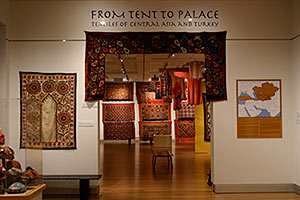Textiles from Central Asia and Turkey
CURATOR'S STATEMENT
by Carel Bertram and Donna Osman Larsen
All along the ancient Silk Road, from Mongolia, through Central Asia and on to Asia Minor and the Mediterranean, were cities made of cloth.
Strong, colorful or stark, metaphorically significant, intensely religious, ritually personal or politically powerful, dyed, woven, knotted and embroidered cloths heralded the peoples that they also enclosed and protected.
Long after the Silk Road closed as a protected trade route in the first century C.E., textiles and ceramics, pomegranates and peaches, ideas and technologies continued to travel along it. In the 8th century this area began to accept Islam, and this became its predominant religion, but with a cultural life shared by Shamans, Zoroastrians, Buddhists, Jews and Christians.
At the center of the silk route were the stopping points of Central Asia. Travelers who visited here in the 15th century noted its villages of cottages and its towns with great monuments; but the most striking and consistent description of what they saw describes a nomadic tradition of textiles. From the welcoming mats spread out for eating in front of felted yurts to the tent metropolis of the Great Turkic ruler, Timurlane, with its domed and awninged tent palaces surrounded by walls of fabric, textiles were a major part of their lives.
 In the middle of the 15th century, at the Western end of the Silk Road, in Constantinople, another Turkic empire, that of the Ottomans, had already formed. Although its palaces and cities would be made of stone and wood, its historic culture of cloth was still vibrant. The most valued gift given by Sultans and wealthy townspeople alike were gifts of cloths and clothing made of locally grown and dyed silks.
In the middle of the 15th century, at the Western end of the Silk Road, in Constantinople, another Turkic empire, that of the Ottomans, had already formed. Although its palaces and cities would be made of stone and wood, its historic culture of cloth was still vibrant. The most valued gift given by Sultans and wealthy townspeople alike were gifts of cloths and clothing made of locally grown and dyed silks.
From Tent to Palace exhibits 19th and 20th century nomadic and urban embroidered and embellished cloths that evoke and continue to evoke this tradition of a life surrounded by fabrics of rich design. The entry room to this exhibit, the room in which you now stand, has textiles grouped by type and some information about them. In the larger gallery, the exhibit is divided into three sections: in the farthest one you will see textiles from the nomads of Central Asia. These include the Turkic speaking Turkmen, Uzbeks, Kazakhs and Kyrgyz. In the front of the gallery, on your right, are textiles of the settled people of Central Asia, mainly Uzbek and Tajik, although many types are found in both nomadic and settled culture. On your left, as you enter, are textiles of the Turkic speaking Ottoman Turks, mostly from their mansions and palaces.
Artistic allusions to these lived worlds punctuate each section: a Central Asian nomadic yurt, and urban dining ensembles from Samarqand and Istanbul. These are meant to give a sense of scale and place rather than accuracy; letting the textiles themselves take pride of place and carry to you their authentic beauty.